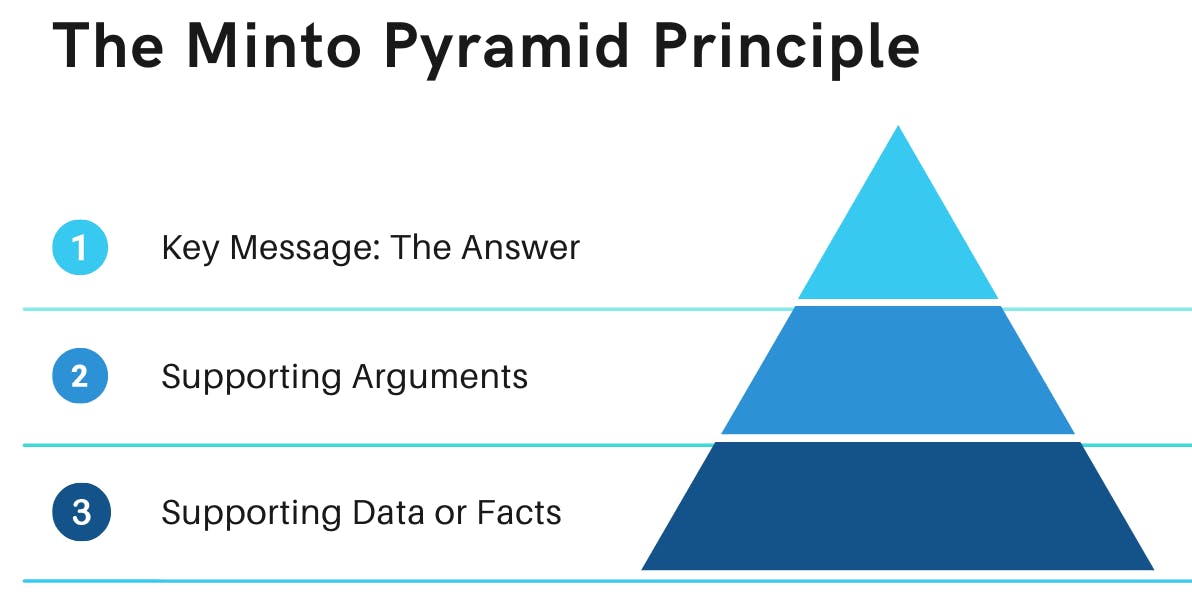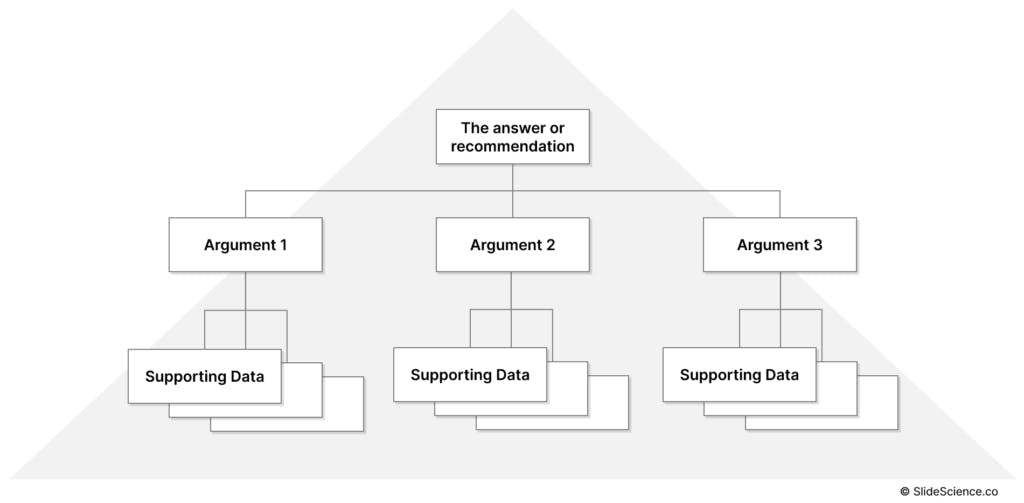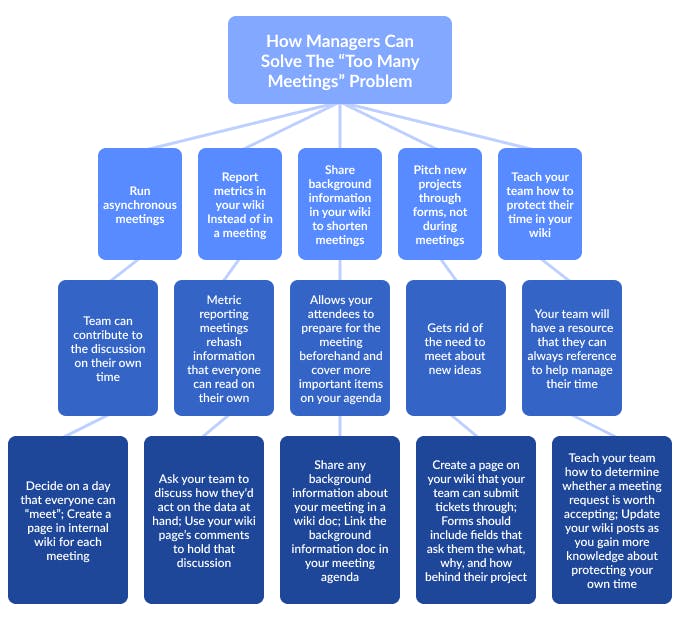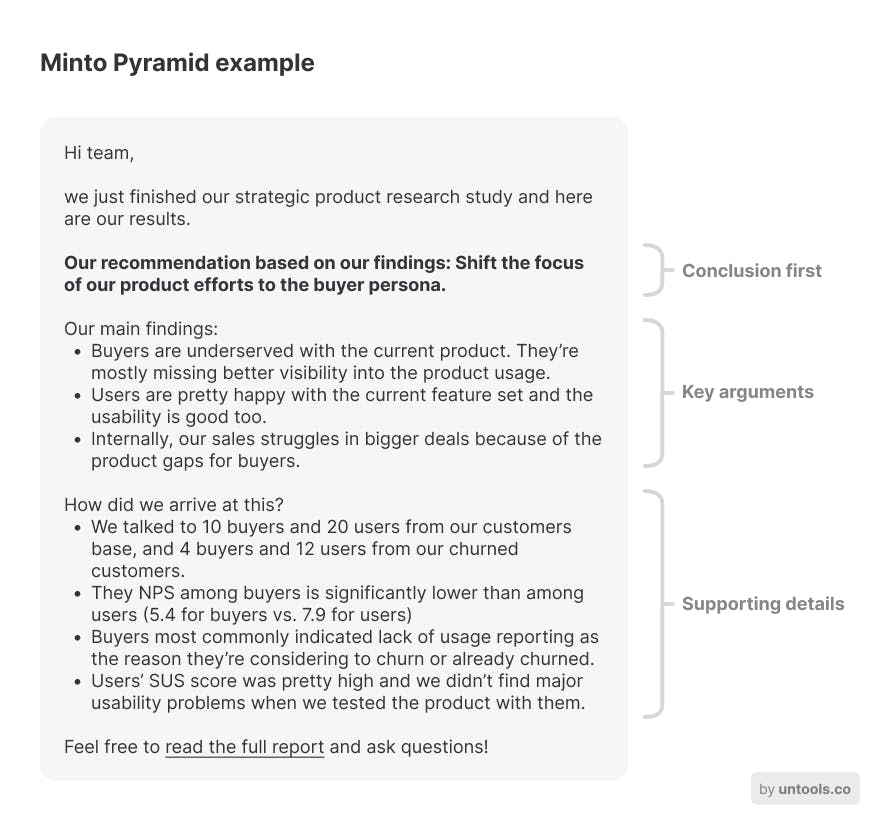The pyramid principle and how to use it in writing and communication
May 30th, 2023

Contents
What is the pyramid principle?
How to use the pyramid principle to structure writing?
Examples of pyramid principle
Good communication is one of the key pillars of successful marketing. It is the only way marketers can inform people about new products and services. In addition, proper communication allows for building and maintaining long-term relationships with target customers and stakeholders and creating an emotional connection with the audience. However, to make sure your ideas and messages are easy to grasp, your presentation should obey several logical rules.
To create a clear and concise message, your efforts should be directed toward answering a question that exists in a consumer’s mind. You can achieve this by organizing your ideas as a pyramid under a single point. This allows you both to save time in preparing a presentation and increase the effectiveness of your work. This technique is called the pyramid principle and can be applied to any type of document, including emails, lengthy reports, landing pages, articles, or presentations. It is effective for internal and external audiences, regardless of language or medium.
In this article, we will discuss the pyramid principle in more depth, consider how to apply it correctly and look at several examples.
What is the pyramid principle?
The pyramid principle is a communication framework that employs an inverted pyramid technique. This tool is used for structuring the information and making a persuasive argument if you want to hold the audience’s attention and compellingly deliver your message. The basic idea of the pyramid principle is to get straight to the point in all written communications. It ensures the audience is engaged and allows for the creation of an appealing story that is easy to remember and understand.
The pyramid principle changes the typical flow of information compared to the way the majority of people naturally respond to questions. According to the framework, the core statement is provided in the article or presentation's beginning. Then the critical point is supported by the reasoning. The detailed data and evidence that back up the arguments are presented last. As a result, this creates a strong basis that substantiates the central statement.

The principle was designed by Barbara Minto, who worked as the training director for the strategy consulting organization McKinsey & Company in the 1970s. The organization found that business school candidates needed more company communication skills despite Ivy League education. So the company gave Barbara Minto the task of improving the firm's customer communications, and she spent more than 20 years training prospective employees to use the principle. Barbara Minto compiled her research in her book The Pyramid Principle, published in 1985. The book became a worldwide best-seller and is still used to educate new employees at McKinsey.
Nowadays, the principle is still recognized as the standard for presenting ideas and arguments in a logical and well-organized way. The framework is an effective tool to help you create convincing articles, white papers, landing pages, presentations, or press releases. Using the pyramid principle, you can reduce the time you spend on writing and ensure that your audience immediately understands what you're trying to say.
How to use the pyramid principle to structure writing?
Let us consider how to use the pyramid principle when preparing presentations, sales pitches, articles, and other forms of written communication.
Step 1. Use SQCA approach
According to the pyramid principle, the introduction to the article or presentation is divided into four components: situation, complication, question, and answer. First and foremost, you must clarify the topic you want to discuss, explain why it is essential, describe the issue you wish to address, and provide the answer. Let us take a more detailed look at this approach.
SCQA is an abbreviation for situation, complication, question, and answer. The situation is the context of the issue you are going to solve. It informs the reader about what is happening. For example, “the company is a renowned car manufacturer.”
Complication is the change in the situation or the underlying cause of the issue. For example, “the company is losing money due to changing consumer behavior and the absence of new clients.” Now everyone can clearly understand the problem. This creates a feeling of urgency and motivates people to pay attention to the issue and take action based on your forthcoming ideas.
The question is a statement of the problem. Once you have determined a problem, you need to develop a hypothesis by asking questions. An assumption is typically falsifiable, which means it can be refuted. Here, you ask questions about the issue and then provide answers. For example, “how the company can reach out to new market segments and encourage them to purchase the products?”
The answer is the solution to the problem and specific recommendations. After confirming your hypothesis, you can organize and present the information to the audience. For example, “the company needs to concentrate its efforts on the light vehicles.”
Step 2. Use vertical and horizontal logic
Barbara Minto states that ideas should always be organized in the pyramidal structure below a single concept. It implies that each point you make should have its own miniature pyramid structure, including the solution, arguments, and data. To maintain the effectiveness of the overall idea and ensure the communication is straightforward enough, every thought should be supported by three arguments. Then, three supporting reasons should back up each of the arguments.
First, arrange your points in logical groupings when presenting them. There are several methods to accomplish this. You can organize the facts according to their importance, sequentially or structurally. For example, if you are discussing sales automation and key performance indicators, present all your arguments about KPIs before talking about automation.
When presenting the ideas this way, you apply both vertical and horizontal logic. The narrative structure is vertical reasoning. Starting with your primary concept, you ask questions and then respond to them with supporting arguments as you move down the pyramid.
The pyramid’s horizontal structure employs either deductive or inductive reasoning. Deductive reasoning implies using a general statement and validating it using supporting arguments. In contrast, inductive reasoning draws a particular conclusion from a group of general supporting statements.

Step 3. Create a list of supporting facts
The next step is to create a list of supporting facts to convince people that your solution is reasonable and based on solid logic. Use the MECE framework to describe the supporting points that back your thesis. According to the principle, you need to sort your arguments into two categories: mutually exclusive and collectively exhaustive.
Mutual exclusion refers dividing a whole into separate, non-overlapping parts. For example, undergraduate students can be divided into freshmen, sophomores, juniors, and seniors. One person cannot belong to more than one of these categories, so these groups do not overlap.
Collectively exhaustive refers to the fact that the categories used to break down the entire population are complete or include all the important components of the group under study. Considering the previous example with undergraduate students, we can imagine that it took five years to complete a degree for some students. Perhaps engineering students required a year of co-op employment before graduation. As a result, you can add the group “fifth-year student” or take into account their work experience when categorizing students.
Each argument can be further backed by supporting facts, depending on the length of your article or presentation and the difficulty of the subject.
Step 4. Add data to back up your assertions
Your central point will be more credible if data, statistics, facts, and outcomes support it. You can use charts, graphs, and statistics to back up your governing thought and give more weight to your solution. It ensures that the pyramid’s central reasoning and key communication point cannot be questioned and supports these facts with actual evidence.
You can be less concise and go into more depth at the foot of the pyramid. Although it is possible that some won't even read that section, it's still crucial because it validates your main point and is required for the suggested answer to be accepted and implemented. In some cases, you can omit this section and still deliver a compelling message if the audience is sufficiently knowledgeable about the subject or if the points contain sufficient proof to support the main idea.
Step 5. Analyze your presentation
You are now prepared to examine the presentation as you have the SCQA narrative, supporting reasoning, and the data to back it up. Check your arguments and logic and review the whole structure. Make sure that the terminology is clear to your audience. You can also use the SCQA logic to prepare a brief introduction to your presentation that summarizes the ideas. Remember to use a call to action and include phrases with a verb whenever possible. Finally, create a list of conclusions you want your readers to reach after reading the paper. Consequently, people will not have to guess how to interpret your words.
Further, we will describe how to apply this principle in practice.
Examples of pyramid principle
We will consider several examples of applying the pyramid principle that illustrate how to write a presentation, email, and article with this method.
Article
The first example is the article 5 Ways Managers Can Solve the “Too Many Meetings” Problem by Tettra. The critical point at the top of the pyramid or the main problem matches the article’s title. Then the writer provides five solutions, including running asynchronous meetings, reporting metrics and sharing information in the wiki, presenting new ideas through forms, and teaching a team to manage their time. Finally, the writer gives a piece of advice after each supporting argument at the foot of the pyramid.

In addition, each part of the article answers a certain question. The subsection header covers the question “what”. For example, “run asynchronous meetings”. The next part of the article provides the background information that explains “why” the author’s solution makes sense and confirms the thesis in the subheader. Finally, the last paragraph of each section answers “how” a reader can solve the problem and offers practical advice on implementing the solution.
This is an example of an email written by a researcher who has just completed a study and wishes to suggest his findings to his colleagues. The email begins with a brief introduction, then comes the conclusion that immediately provides recommendations to the readers. Then the author presents the main findings or key arguments that demonstrate why it is necessary to solve this problem and apply the suggested solution. In the last part of the email, the writer gives the supporting details of the research. These details include statistics and facts found during the study. The closing sentence contains a call to action, encouraging readers to learn more information and ask questions.

Presentation
The following example is a presentation by McKinsey concerning emerging economies which they call “outperforming economies”. The title of the slide is the key point of the presentation. It illustrates three factors that have driven the development of the economies: productivity, growth, and demand. It's easy to identify the various levels of the pyramid since the slide includes several data points and an appealing visual. Here we can observe three key arguments: higher productivity, strong and inclusive growth, and boosting demand. The arguments are backed up with supporting details, such as facts and statistics.

Overall, a pyramid principle is a great tool that will improve the clarity and quality of your copywriting. You'll start with the conclusion, present the main points, and then provide details to back them up. Your audience will be grateful, and you will be delightfully surprised by the outcomes.
